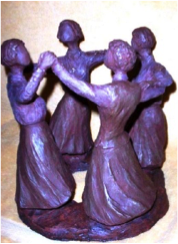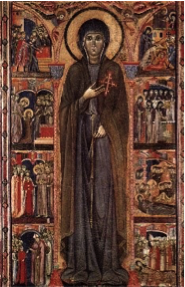 I was going to write this as a reflection on the life of Saint Clare, given her feast day is this week (August 11) and that there are so many interesting facts and stories about her life. Then a different, but related, reflection came to mind…
I was going to write this as a reflection on the life of Saint Clare, given her feast day is this week (August 11) and that there are so many interesting facts and stories about her life. Then a different, but related, reflection came to mind…
Seven years ago, being a relatively recent convert to Catholicism, I had no idea who the Poor Clares were. However, I gained some new “sisters” when I started a diocesan two-year faith development program that year and was fortunate enough to have two Poor Clare nuns of the Order of St. Clare (OSC) in my class. The Poor Clares take vows of poverty, obedience, chastity, and enclosure and are followers of St. Francis and St. Clare of Assisi, living the simple, Gospel life in an enclosed contemplative community. The variety of Poor Clare expressions includes the Order of St. Clare (OSC), the Colettine Poor Clares (PCC), Capuchin Poor Clares (OSC Cap), and Poor Clares of Perpetual Adoration (PCPA). No matter the expression though, the Poor Clare life of prayer is possible because they do live in community. I am now profoundly involved with the Monastery of St. Clare in Great Falls, Montana and count the nuns of the Poor Clares of Montana, who I affectionately call my sisters, amongst my dearest friends. My sisters have taught me a few things…
 Sisters Maryalice, Catherine, Jane, and Judith Ann all came to Great Falls 16 years ago at the invitation of the Bishop of the Diocese of Great Falls-Billings, who wanted to bring a monastic presence to the state of Montana. Each sister came from a separate monastery of the Holy Name Federation of Poor Clares along the eastern seaboard. I did not know the sisters then, but I am in awe at their courage, tenacity, and conviction to pull-up their roots and move west to this beautiful, but unknown land, to start the first monastic presence in Montana. They did not know each other well, had never lived in Montana, and had no monastery to occupy. I have moved around a lot in my life, but my horizon was never as uncertain and rocky as was the horizon for these four amazing women. Their story on starting the first monastery in Montana echoes St. Clare, who ran away from her familiar surroundings, wealthy family, and pending marriage in 1212 to join St. Francis in a life dedicated to God. My sisters, you have taught me to trust God’s providence, discern God’s call, and follow that call with all my heart no matter how difficult the road ahead seems.
Sisters Maryalice, Catherine, Jane, and Judith Ann all came to Great Falls 16 years ago at the invitation of the Bishop of the Diocese of Great Falls-Billings, who wanted to bring a monastic presence to the state of Montana. Each sister came from a separate monastery of the Holy Name Federation of Poor Clares along the eastern seaboard. I did not know the sisters then, but I am in awe at their courage, tenacity, and conviction to pull-up their roots and move west to this beautiful, but unknown land, to start the first monastic presence in Montana. They did not know each other well, had never lived in Montana, and had no monastery to occupy. I have moved around a lot in my life, but my horizon was never as uncertain and rocky as was the horizon for these four amazing women. Their story on starting the first monastery in Montana echoes St. Clare, who ran away from her familiar surroundings, wealthy family, and pending marriage in 1212 to join St. Francis in a life dedicated to God. My sisters, you have taught me to trust God’s providence, discern God’s call, and follow that call with all my heart no matter how difficult the road ahead seems.
 In the time that I have known them, the Poor Clares of Montana have faced numerous, varying tribulations, and in each of those situations, they relied on the power of prayer (ok, no surprise there, that is their vocation – to pray, to pray with and for all of God’s people). Witnessing the sisters’ trials brings to mind St. Clare herself who faced many struggles including years of difficulty in obtaining papal approval of the form of life she and her sisters lived, a life she called “the privilege of highest poverty.” The effect of St. Clare’s prayers also come to mind as her prayers are credited with obtaining victories in turning back invaders of Assisi as well as numerous healings. My sisters, your witness to the power of prayer and reliance on Divine Providence have helped me to deepen my prayer life and ultimately my relationship with Christ.
In the time that I have known them, the Poor Clares of Montana have faced numerous, varying tribulations, and in each of those situations, they relied on the power of prayer (ok, no surprise there, that is their vocation – to pray, to pray with and for all of God’s people). Witnessing the sisters’ trials brings to mind St. Clare herself who faced many struggles including years of difficulty in obtaining papal approval of the form of life she and her sisters lived, a life she called “the privilege of highest poverty.” The effect of St. Clare’s prayers also come to mind as her prayers are credited with obtaining victories in turning back invaders of Assisi as well as numerous healings. My sisters, your witness to the power of prayer and reliance on Divine Providence have helped me to deepen my prayer life and ultimately my relationship with Christ.
 Each Poor Clare community is unique as each monastery is autonomous while expressing the Poor Clare spirit of evangelical poverty, prayer, and contemplation, and t he nuns of the Poor Clares of Montana reflect St. Clare’s charisms in their own exceptional way . As a small community (the same four who were the foundresses here 16 years ago are the same four who are the community today), each nun has an enormous workload to keep the monastery running as well as to try to grow her community all while keeping her emphasis on enclosure and prayer. You would think enclosure would ensure a level of certainty, but each day is distinctive for these women. Yet, somehow, the sisters maintain their prayerful focus. What they encounter in the work of each day, likely, is not very different from what St. Clare went through in starting the Order of Poor Ladies of San Damiano over 800 years ago – all the responsibility initially falls on a few until the community can grow. My sisters, you have taught me no matter what each day brings to rely on Christ and persevere through prayer.
Each Poor Clare community is unique as each monastery is autonomous while expressing the Poor Clare spirit of evangelical poverty, prayer, and contemplation, and t he nuns of the Poor Clares of Montana reflect St. Clare’s charisms in their own exceptional way . As a small community (the same four who were the foundresses here 16 years ago are the same four who are the community today), each nun has an enormous workload to keep the monastery running as well as to try to grow her community all while keeping her emphasis on enclosure and prayer. You would think enclosure would ensure a level of certainty, but each day is distinctive for these women. Yet, somehow, the sisters maintain their prayerful focus. What they encounter in the work of each day, likely, is not very different from what St. Clare went through in starting the Order of Poor Ladies of San Damiano over 800 years ago – all the responsibility initially falls on a few until the community can grow. My sisters, you have taught me no matter what each day brings to rely on Christ and persevere through prayer.
The Poor Clares of Montana recently started offering contemplative prayer workshops and Christian meditation prayer groups, bringing the Catholic Church’s rich Desert tradition of prayer to the local laity. I am amazed that these women (all who have been involved with prayer for decades longer than I have) continue to expand and deepen their relationship with Christ by embracing various expressions of prayer, adding to their repertoire of vocal and silent prayer methods. I am reminded of St. Clare’s words, “Gaze upon Christ, consider Him, contemplate Him, as you desire to imitate Him.” My sisters, you have shown me the power of praying silently in a group as a way of cultivating my relationship with Holy Trinity, as a way of responding to God’s presence in the world.
My sisters live for God alone, dedicating their whole being to God in a life expressed in community, silence, solitude, and prayer. I am grateful for their prayer, their presence, and the peace that they bring me as well as the whole community of God’s people. The Monastery of St. Clare in Great Falls is the only monastery in the state of Montana, but like the dozens of Poor Clare Monasteries in North America and the over 900 in the world, the Poor Clare nuns, following in the footsteps of St. Clare, are here for all of us – my sisters are our sisters. Thanks be to God.
Fawn Waranauskas teaches in the Catholic Catechesis Certificate Program for Saint Joseph’s College Online.
 insisted, for instance, that she be the last to be served at meals in her community. This action demonstrated her desire to identify with the poor who seldom if ever are first to be seated at table and then have to accept whatever is left to eat. Catherine’s way of viewing dress demonstrated her resolve to live out her option for the poor. She often “deprived herself of articles of dress. . . to relieve the necessities of her neighbors.”[1] Regarding dress, Catherine advised her Sisters:
insisted, for instance, that she be the last to be served at meals in her community. This action demonstrated her desire to identify with the poor who seldom if ever are first to be seated at table and then have to accept whatever is left to eat. Catherine’s way of viewing dress demonstrated her resolve to live out her option for the poor. She often “deprived herself of articles of dress. . . to relieve the necessities of her neighbors.”[1] Regarding dress, Catherine advised her Sisters:



